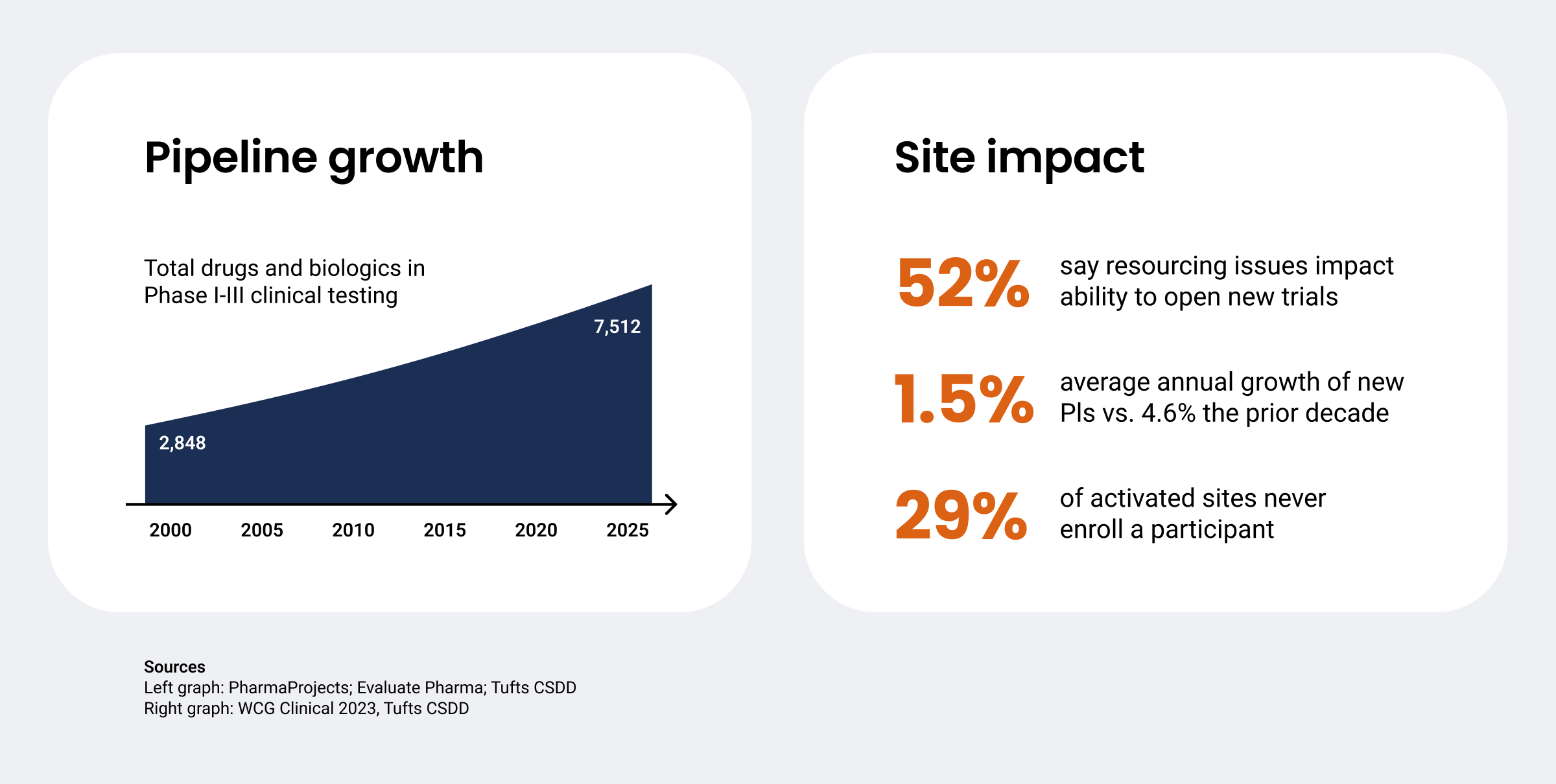4 Site Engagement Strategies from Top Sponsors, CROs, and Clinical Research Sites
Clinical research site demand is at an all-time high, but their capacity is shrinking amid increases in protocol complexity and fragmented technology solutions.

Although most sponsors understand the urgency and value of improving site relationships, it can be difficult to implement effective strategies that don’t exacerbate existing site challenges.
Recently, we had the pleasure of hosting a roundtable discussion with several top 20 and large biopharmas, CROs, and sites to dive into all things site engagement. Here are four key learnings from the discussion to help organizations looking to strengthen their relationships with research sites.
1. Prioritize long-term relationships
Amid high staff turnover, many sponsors and CROs have appointed ‘site engagement leads’ as a long-term single point of contact for PIs and coordinators. This can help maintain continuity for sites, especially during staff changes. Organizations should also take time to explain the role of each person who reaches out to a site and provide a clear contact for site challenges, such as patient situations that need extra attention.
Sponsors and CROs are also working on ways to retain ‘institutional memory’ to ensure that site interactions are documented and the relationship stays intact despite staff changes. Technology can help with these efforts by streamlining and digitizing site-sponsor interactions, including escalations tracked by the site.
2. Standardize and integrate technology
Many sponsors and CROs hear feedback from sites that they have too many technology solutions. In a recent SCRS survey, only 5% of sites said that sponsor technology meets their needs “very well.” A significant contributor to this challenge is the proliferation of one-off point solutions, leaving sites with countless applications, logins, passwords, and portals. On average, sites use around 12 distinct technological components in each trial.
For example, many sponsors have individual solutions to manage study documents, safety letter distribution, payment letters, and end-of-study media. Instead, sponsors can look for solutions that unify these capabilities under one login. This way, sites can have everything they need in one place, giving them more time to connect with patients.
3. Engage early to implement feedback
Traditionally, sponsors and CROs may ask sites for their feedback when the draft protocol is nearing its final stages. But, that norm is changing as more sites are asking sponsors and CROs to engage them much earlier in protocol design. This gives organizations enough time to incorporate site feedback and ensure feasibility.
During the roundtable, sites shared that they are often asked for feedback from sponsors, but they may never hear back from them. Some sponsors are implementing new initiatives beyond their conversations with key opinion leaders (KOLs) to ensure that sites feel included in trial decisions. One sponsor had potential technology vendors for an upcoming trial pitch themselves to 10 different sites to see what tools the sites preferred. The vendors were happy to participate, and site staff were happy to weigh in. Another sponsor created a paid study coordinator council to solicit feedback on how to simplify trials for sites.
4. Enhance support for new investigators
Per ICH E6(R3), the investigative site now has to provide evidence of oversight processes, including providing evidence of task-based training. Sponsors and CROs can help sites with their internal processes and invest in PI development to ensure that they remain in compliance.
Even though the guideline is not set to be finalized until July, regulators expect sponsors and CROs to already be planning their training strategies for ongoing and future studies. For example, one sponsor recently experienced an EMA inspection where the inspector asked if all PIs had been trained on ICH E6(R3) yet.
To meet these requirements, many sponsors and CROs are adopting risk-based approaches to study training. By putting proactive measures in place, organizations can identify sites that may need additional training before compliance issues arise. New technology can also help sponsors notice trends with individual PIs, like late data entry and quality issues. Then, sponsors can choose whether to provide them additional training or halt recruitment until the trial is back on track.
Although these new regulations can be challenging, many sponsors and CROs are using ICH E6(R3) as an opportunity to shift their perspectives on study training. Instead of prioritizing tracking and compliance, they are focusing on the value and benefits the training brings to sites. Organizations have implemented new programs, including:
- Offering mentorship and additional support for new sites and PIs, particularly in niche research areas like psychedelics
- Asking training participants to indicate their confidence in their quiz answers to see who fully understands the content and who may need additional support
- Using behavioral science principles to make training more engaging
- Collaborating with companies like Fortnite to gamify their training
- Tailoring training content based on the topic, including videos, infographics, and other formats to improve learning outcomes
- Assigning training specific to each site staff member’s role and responsibility in coordination with trial milestones, such as the first patient screening
Ultimately, making a strategic effort to refocus on the fundamentals is the key to improving site collaboration in the long term. Engaging sites and giving them a seat at the table will lessen the transactional nature of site-sponsor relationships and streamline study execution. An effective site-centric approach can be straightforward: prioritize site input and foster collaboration to ensure better clinical trial outcomes for all.
Read a recent Q&A with a site leader to learn more about how sponsors and CROs can better support sites.